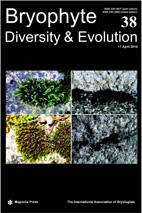Abstract
Two closely related tropical genera from the pleurocarpous moss family Neckeraceae are revised: the second largest genus in the family, Neckeropsis, currently with 29 species, and Himantocladium, comprising six species. Twenty-one species of Neckeropsis and five of Himantocladium were included in this study, which is based on phylogenetic analyses using sequence level data from the plastid (rps4)-trnT-trnL-trnF cluster and rpl16 as well as nuclear ITS1 & 2. Neckeropsis appeared as polyphyletic. Neckeropsis s. str. comprises 12 species and a further four species, not included in the analysis, are tentatively retained in the genus based on morphology. Four new genera are segregated from Neckeropsis: Pengchengwua (with one sp.), Planicladium (two spp.), Pseudoparaphysanthus (five spp.), and Neckeromnion (five spp.). Neckeropsis gracilis is synonymized with Neckeromnion urocladum and reported for the first time from Laos. Four molecular analyzed species are resolved in the Himantocladium s. str. clade, with a fifth species being added solely on morphological basis. Himantocladium formosicum is transferred to Neckeropsis. Leaf-like paraphyses (ramenta), unique in Neckeropsis s. str., have evolved two times. In addition, the rare Noguchiodendron sphaerocarpum from the Himalayan region, the single species in its genus, was included in a phylogenetic analysis for the first time and it was found to be closely related to the Asian genus Taiwanobryum.

